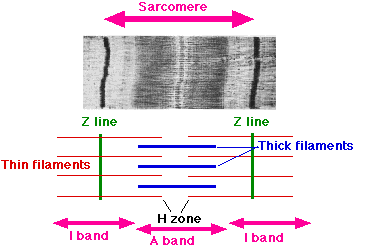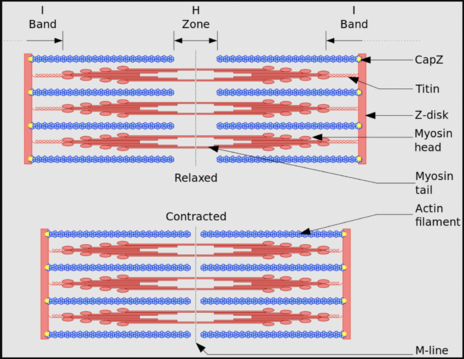Sarcomere
Original Editor - Lucinda hampton
Top Contributors - Lucinda hampton and Vidya Acharya
Introduction[edit | edit source]
A sarcomere is the basic contractile unit of myocyte (muscle fibre). A sarcomere is composed of two main protein filaments (thin actin and thick myosin filaments) which are the active structures responsible for muscular contraction. The widely accepted theory describing muscular contraction is called the sliding filament theory, which proposes that the active force is generated as actin filaments slide past the myosin filaments, resulting in contraction of an individual sarcomere[1].
Sliding Filament Theory[edit | edit source]
The sliding theory, proposed by scientists, who through the use of high-resolution microscopes visualised the actin and myosin filaments within a sarcomere. They could see length of the sarcomere when relaxed and its shortening as it contracted, and were able to give names to particular zones.
- A bands (or anisotropic bands): It is also called the dark band and contains the whole thick filament (myosin).
- I bands (or isotropic bands): it is called the light band that contains only the thin filament (actin). The thin filament lies between the two thick filaments.
- Z disc: it is the area where two actin filaments connect and transverse the I bands. Similarly, sarcomere can also be described as the structure between the two z discs.
- M line: M line contains the protein called myomesin and it marks the centre of the sarcomere.
- H zone: it is the area between the M line and Z disc and this zone contains only the myosin[2].
Sub Heading 3[edit | edit source]
In essence, during contraction a sarcomere shortens like a collapsing telescope, as the actin filaments at each end of a central myosin filament slide toward the myosin's centre, as described below.
The thick myosin filament contains numerous heads, which when attached to the thinner actin filaments create actin-myosin cross bridges. A myosin head binds with an actin filament flexing and producing a power stroke. The power stroke slides the actin filament past the myosin, resulting in force generation and shortening of an individual sarcomere. Because sarcomeres are joined end to end throughout an entire muscle fiber, their simultaneous contraction shortens the entire muscle.[1]
Resources[edit | edit source]
- bulleted list
- x
or
- numbered list
- x
References[edit | edit source]
- ↑ 1.0 1.1 Mansfield PJ, Neumann DA. Essentials of kinesiology for the physical therapist assistant e-book. Elsevier Health Sciences; 2018 Oct 23.Available:https://www.sciencedirect.com/book/9780323544986/essentials-of-kinesiology-for-the-physical-therapist-assistant (accessed 10.7.2022)
- ↑ The biology notes Sarcomere Available:https://thebiologynotes.com/sarcomere/ (accessed 10.7.2022)








